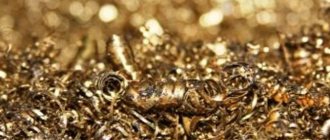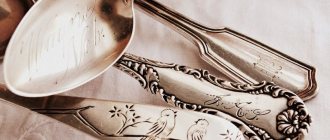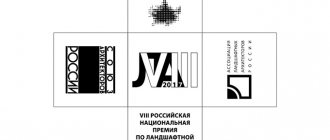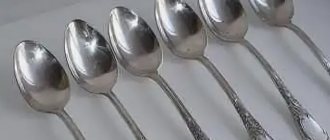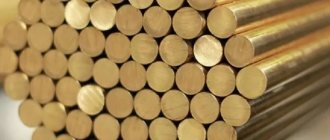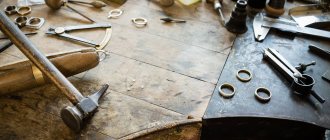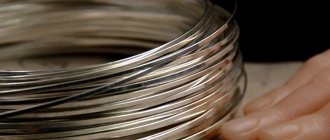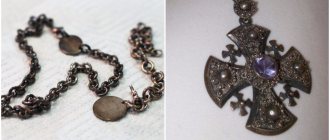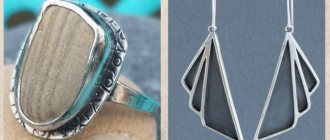Cutlery made of cupronickel and silver has always been a source of family pride. They were taken care of, passed on by inheritance, and in tight financial circumstances they were in no hurry to take them to a pawnshop. Silver tableware items are not inferior in price to jewelry. They are indispensable for holiday serving, but they can also be used every day, since with proper care, such dishes can last a very long time, maintaining a beautiful appearance. It turns out that tableware made of silver and cupronickel are very practical, but only if they are of good quality. In this article we will tell you how to choose the right silverware and how to care for it.
History of nickel silver
The appearance of nickel silver is directly related to cupronickel, which was invented in China. The Chinese protected the cupronickel formula no worse than the secret of creating silk. This is not surprising, because it had completely unique qualities, could replace silver, but at the same time was several times cheaper.
Over time, cupronickel began to be popular among European secular society, which is why they really wanted to reveal the formula of this strange alloy. The best minds in Europe tried to solve this riddle. Whether long or short, chemists discovered the composition of the alloy, which they thought included copper, nickel and zinc. However, they were unable to calculate the ratio of these metals.
I don’t know how things went there, but apparently they didn’t pat the chemists on the back and suspended all research for almost 300 years. And in the 19th century, German researchers were still able to produce a sample of “cupronickel,” which in fact turned out to be not cupronickel at all. Research has shown that this metal was much stronger and more stable; the material is destroyed only in boiling hydrochloric and sulfuric acids.
Thus, German chemists managed not only to repeat the Chinese formula, but also to discover a new alloy of nickel silver. Silver, cupronickel and nickel silver look exactly the same, at first glance it is impossible to distinguish them. However, the cost of nickel silver is the lowest. It is precisely because of its similarity with silver that jewelers began to actively use nickel silver.
We are also preparing to cast our products from nickel silver. This is economically beneficial for you, our dear customers, because its cost will be in the same price category as bronze. This material is resistant to corrosion and temperatures, does not oxidize, does not turn black and does not change its properties over time. Jewelry made from nickel silver looks as much like silver as possible.
It is possible to distinguish them only by checking the sample. So, silver will have a 925 standard, but nickel silver will not have it at all, or in some cases they will put three letters “mnc”, which means copper, nickel and zinc.
Nickel silver alloy
Many people may have a question: what is nickel silver?
Nickel silver is an alloy of zinc, copper and nickel. Lead may also be added to it for better mechanical processing.
The presence of zinc makes nickel silver cheaper than cupronickel, which is similar in appearance and has similar mechanical properties. The alloy in question belongs to the group of corrosion-resistant alloys made of copper and nickel. The entire group of alloys from “new silver” has other names: German silver, nickel silver, white metal, argetan, alpaca, cupronickel and others.
Nickel silver has the following markings: abbreviations MNC (copper, nickel, zinc). Next, the percentage of nickel and zinc is prescribed. For example, MNC 25-20 (Ni – 25%, Zn – 20%, the rest Cu). When adding lead, C is added to the name - MNTS. There are approximately 50 types of alloy, but the most common are the grades MNTs 15-20, MNTsS 16-29-1.8.
Each metal in a given alloy has a specific meaning:
- Nickel provides strength and corrosion resistance. When it reacts with copper, it produces a compound that has greater density and hardness. Together they increase the mechanical parameters of copper by approximately 10 times, and its oxidation resistance by 3 times. However, the high nickel content makes the alloy significantly more expensive, and it cannot be processed in red-hot heat;
- zinc replaces nickel. In terms of corrosion resistance, it is inferior to nickel, but is a cheaper metal. The alloy becomes the hardest due to zinc. Due to the annealing procedure, hardness values can be up to 30 HRC. In terms of this value, “new silver” is superior to cupronickel. It also increases electrical resistance and machinability. However, zinc reduces the ability to withstand heat;
- Lead is needed to impart ductility. It makes him pliable. Nickel silvers, which contain lead, are distinguished by the fact that it is not possible to carry out hot pressure treatment with them. The reason for this is that the melting point of lead is at a low level, so hot brittleness defect may be formed.
How to clean nickel silver?
There are a huge number of options available and you can clean nickel silver at home. To do this, you can use toothpowder or toothpaste, dishwashing powder, salt or soda. These are simple solutions that will help bring back the “newness” of your jewelry. Very soon you will be able to purchase nickel silver products in our store. In the meantime, don't forget that you can always buy silver or bronze. Products from which are not inferior in quality and characteristics.
Chemical properties
The alloy composition has the following chemical properties:
- good resistance to destructive environmental factors;
- it does not oxidize in air. At temperatures up to 250 ˚С there is no chemical reaction between nickel silver and atmospheric gases;
- increased resistance to corrosion, to a large number of acids, especially organic acids. To increase the corrosion resistance of nickel silver products, immerse them in an aqueous solution of sulfuric acid after cleaning, then rinse them with water and dry them;
- inert to salts.
Resistance to external environmental factors and other characteristics of nickel silver determine its widespread use.
Nickel silver casting
Friends, as it turned out in practice, casting nickel silver is not a simple matter. When I tried to independently form a nickel silver alloy using formulas from the Internet, I was not successful. The defect rate reaches 90%, which is very high.
Consultations with specialists who have experience working with nickel silver alloy showed that a good indicator of the quality of injection molding in open systems is a defect rate of 50%. As a result, by selecting the metal recipe, we managed to reach the quality/defect mark of 50/50.
Later, it became known for certain that obtaining 100% casting quality is possible only by using certain alloys and only one type of injection molding machines. Although this fact can also be considered dubious.
Nevertheless, in the end we achieved almost 100% quality of finished products. The actual defect rate at the time of writing this article is 95%. Out of 100 decorations placed on the Christmas tree, only 5 were defective. Upon closer examination, it turns out that 5 defective works can be attributed to defective wax models, bubbles under the surface of the wax.
Now the nickel silver alloy is in mass production and in principle no problems arise with its casting.
When casting this metal, special attention must be paid to the casting machine and not to the alloy itself. It is also necessary to strictly adhere to the production technology as a whole, from the moment of forming the tree, the time between evacuation of the flask and before placing it in the muffle furnace.
The diameter of the gating system is also important, although on certain closed-type machines this parameter is not important.
Useful and harmful properties
Cupronickel is an alloy whose main component is copper. There is a misconception that using such utensils can be harmful to health. When used correctly, kitchen utensils made of cupronickel are completely safe.
The advantages of cupronickel include:
- The durability and strength of cupronickel cutlery - the low cost of the material allows the products to be produced more massive, which ensures their strength. Also, cupronickel, due to its chemical composition, is almost resistant to mechanical damage, unlike silver.
- Cupronickel silverware looks aesthetically pleasing - when serving, the cutlery looks expensive, the silver-plated coating makes them almost indistinguishable from silver.
- Products made from cupronickel do not corrode; with proper care, they can last for several generations.
- The low thermal conductivity of the alloy makes it comfortable to use. Unlike silver, cupronickel heats up very slowly.
Cupronickel silver cutlery also has some disadvantages:
- If not properly cared for, the products may darken. This can be avoided by protecting the dishes from moisture. It is not recommended to use products containing abrasives to wash products. If the appliances do become dark, they can be easily lightened by cleaning them at home.
- Uncoated table nickel silver can impart a slight metallic taste to food. It is insignificant and will not be noticeable to every person. To avoid this, a layer of tin can be applied to the product. Only after this is it coated with silver or gold.
- There is an opinion that cupronickel is harmful to health, since when heated, as well as as a result of contact with certain products, copper oxidizes and releases toxic substances. To prevent this from happening, nickel silver cookware is not recommended for cooking on the stove or in the oven.
Cupronickel tableware is more demanding to care for than items made from stainless steel and other materials. But it perfectly emphasizes the sophistication of the festive table setting.
Cupronickel alloys
Cupronickel alloys have different percentage compositions. The most common cupronickel alloy contains from 5 to 30 percent nickel, with the remaining percentages being iron (0.8 percent) and manganese (0.1 percent). There are other alloys that are very similar in their chemical composition to cupronickel, but have different names:
- Cupronickel, similar to cupronickel, contains only copper and nickel in equal proportions;
- Monel, contains up to 67 percent nickel;
- nickel silver, contains additional zinc;
- Constantan, very close in chemical composition to cupronickel, contains 55 percent copper and 45 percent nickel.
Physical properties of nickel silver
The GOST 5187-2003 standard regulates the incoming elements of nickel silver. According to this document, the alloy in question must contain:
- nickel: from 5 to 35%. The alloy has a yellowish-white tint with a nickel content of 5-10%, and with a nickel content of 20-30% it is silvery-white;
- zinc: 13-45%;
- copper: remainder;
- Lead may be added up to 5%.
Download GOST 5187-2003
The most common percentage of metals included in this alloy:
- copper – 65%;
- zinc – 20% (main component);
- nickel – 15%.
The main physical properties of this alloy include:
- density 8700 kg/cub.m.;
- zinc and nickel reduce electrical conductivity. The electrical resistivity is 0.26 ohm×mm2/m. This is 30 times more when compared with the same indicator for copper;
- the average thermal conductivity is 0.06-0.085 cal/cm×C. That is, the alloy in question conducts heat poorly;
- Nickel silver does not have a high rate of expansion with increasing temperature. When the temperature rises to 100˚C the alloy expands only 16.6 microns.
Properties of cupronickel
Cupronickel is very similar in appearance to silver. Sometimes it can be very difficult to distinguish cupronickel silver items from silver items. Cupronickel alloy is a well-known imitation of silver. Especially the cupronickel alloy perfectly imitates silver in jewelry. Some unscrupulous traders sometimes try to sell nickel silver items by passing them off as silver.
Cupronickel silver products are often coated with silver. Cupronickel silver-plated cutlery and crockery look like real silverware. Therefore, when buying silver jewelry and cutlery, we need to look very carefully at what we are buying. Cupronickel has greater mechanical strength compared to silver. Cupronickel alloy has high corrosion resistance and good plastic properties. Due to its high plastic properties, cupronickel alloy is easy to process. Cupronickel alloy produces elegant and sophisticated products.
What is silver hallmark?
The main property of any silver item is its fineness, which determines the proportion of pure silver in a particular alloy. High-quality cutlery usually has a standard of 800 and above, that is, per 1000 g of product there are 800 g of pure silver and 200 g of alloys. The most popular impurity is copper; with it, silver acquires a golden hue. Cutlery in 830 and 875 looks lighter and shinier, but the highest quality silverware starts in 916 and 925. The higher the standard, the more beautiful the products! In addition, pure silver has bactericidal properties, so it is useful to drink from such dishes. In the East you can find cutlery made of 1000-carat silver: they are used exclusively for health purposes, since such products are characterized by low strength. In addition to copper, nickel is popular as an additional impurity - such alloys improve the wear resistance of products and extend their service life.
How to distinguish cupronickel from silver
6 ways to distinguish cupronickel from silver:
- if the product bears the abbreviation MNC (an alloy of copper, nickel and zinc) instead of a sample, it is cupronickel;
- hold the product in water - nothing will happen to the silver, and cupronickel will become covered with a green coating;
- rub the surface of the product with a lapis pencil - the silver will not change, but a dark spot will appear on the cupronickel;
- you can weigh two similar products - nickel silver is lighter than silver;
- smell the object being examined - cupronickel smells like copper;
- use iodine - silver in the sun will darken in the place where iodine was used.
Cupronickel has a melting point of 1170 degrees, higher than that of silver (960 degrees). The melting point of various cupronickel alloys can vary depending on the component composition.
Cupronickel alloy has a structure that allows it to be mechanically processed both hot and cold. Cupronickel is well processed, alloyed with other metals, cut, forged, embossed, stamped, polished and soldered.
3 Ways to Effectively Clean Gold to Make It Shine
Mechanical properties
The main mechanical properties include:
- melting point: 1080 ˚С. Complete melting occurs at 1200 ˚C;
- increased strength when compared with other alloys of copper and nickel. A high rate provides additional alloying of zinc. Strength is 38-45 kg/mm2;
- deformation begins at 10 kg/mm2;
- slight elasticity. The Young's modulus of the alloy is not more than 14,000 kg/mm2. This indicator for structural steel is 20,000 kg/mm2;
- retains its metallic appearance when immersed in water;
- does not dissolve in organic acids diluted with water, acetic and lactic acid;
- has good ductility in hot and cold. The relative tensile elongation is 25-45%, and the contraction elongation is 32%.
Thanks to these indicators, this alloy is widely used in the production of various types of products. Alloys easily lend themselves to pressure processing options such as embossing, broaching, and stamping.
Cupronickel silver cutlery: alloy composition
An alloy of light-colored metals, which is now universally known under the name cupronickel, appeared in ancient times. In Mesopotamia, around the third century BC, it was called white copper and was widely used in the production of utensils, various vessels and household items. Then, in numerous wars and under the influence of time, the secret of alloy technology was lost for several thousand years.
It is believed that cupronickel was invented, or rather recreated, by the French inventors Maillot and Chaurier in the nineteenth century. Despite the fact that the invention was made by the French, cupronickel silver was called “German silver” for a long time. Kitchen utensils, dishes, church vessels, and decorations were made from it.
Cupronickel silver coins (MNC) and nickel silver coins
Many of us are familiar with cupronickel, or as it is also called “new silver,” for cutlery and various jewelry made from this alloy, as well as for the manufacture of some medical instruments, but not everyone knows that cupronickel has also been used in various years and is used today for the production of small change coins of various denominations, as well as for the production of collectible and souvenir coins. Cupronickel (from the German Melchior) is a white alloy of copper and nickel (sometimes with the addition of some metals). The color and properties of cupronickel alloy are very similar to the properties and color of silver. It is exactly the same white color, cupronickel is not magnetite, and when moisture comes into contact with it, it does not produce bad oxidations (which are characteristic, for example, of iron). There are no noble metals in Cupronickel alloys, but cutlery is usually coated with silver.
This coating makes cutlery just as attractive as something made entirely of silver. at the same time, products made from cupronickel create the appearance of a product made from homogeneous silver. When coated with silver, it also eliminates contact of the base alloy (nickel silver) with the skin and consumed food. Nickel and zinc under certain influences behave worse than noble silver and can cause allergies in some people. The structure of cupronickel alloys is a solid solution, and they are perfectly amenable to processing, both hot and cold. The alloy was used in the minting of cupronickel coins and medals. This alloy is also used today when it is necessary to make high-quality copies in a HOMOGENEOUS WHITE METAL LIKE SILVER. For example, a high-quality copy of the ruble coin 1764 (cupronickel silver coins). In addition, cupronickel has high corrosion resistance to both sea and fresh water, various atmospheric influences and dry gases. An alloy similar to nickel silver, “nickel silver” is an alloy consisting of 20% zinc, 50-66% red copper and 13-20% nickel. Depending on the nickel content (the more there is), the alloy is more expensive and stronger. Due to the zinc content, the nickel silver alloy is somewhat cheaper than cupronickel, which is almost similar in appearance and mechanical properties. However, nickel silver is slightly darker in color, its color slightly green. It is enough to remember the color of the old Soviet change (nickel silver coins). One of the alloys used in minting coins was nickel silver alloy. Nickel silver coins, like cupronickel coins, are not magnetic. For example, a high-quality copy of a 37 ruble 50 kopeck coin made of nickel silver (with patina). Nickel silver is characterized by the same corrosion resistance, an increased degree of strength and elasticity during deformation, and fairly satisfactory ductility in cold and hot conditions. It has a nickel silver silver color. Nickel silver alloy is alloyed for better machinability with lead. Nickel silver coins are also very similar to silver. The corrosion resistance of cupronickel and nickel silver increases in proportion to the increase in the percentage of nickel in the alloy. If we look at history, an alloy of nickel and copper was produced in Europe back in the 3rd century. BC era and called it “white copper”. The name cupronickel comes from the names of the inventors of this alloy from France, Maillot and Chaurier. Elton Mayo (photo by Elton Mayo) Over time, the name of this alloy “Maillot-Chorier”, as it was called in France, was distorted in Germany and began to sound as we said above - “Melchior”. Already from German the word “cupronickel” came into the Russian language in this form. Today, cupronickel coins, perhaps the most common in the world, are made using an alloy of 25% nickel and 75% copper, with small additions of manganese. In general, cupronickel is considered a valuable alloy in appearance and quality very similar to silver. Note that cupronickel products always look rich and aesthetically pleasing, and cupronickel coins or nickel silver coins are similar in properties to silver and have good characteristics.
As mentioned above, various items are made from this alloy, especially various jewelry, medical instruments and cutlery. As for coins, the technology of casting such alloys dates back to China in the 8th century. BC era. The required proportions were created by a Chinese metal craftsman at the court of Emperor Li Lian Yin. This master was an experimenter and was fond of mixing various metals in different proportions. From the alloys obtained in this way, he made various decorative items for the court. At the time when the master lived, a decision was made in China to introduce a single banknote. And since the Celestial Empire was not particularly rich in silver and gold, master Lin Yin was ordered to find a worthy replacement for silver. And he fulfilled this order with dignity. In Russia during the empire, cupronickel (nickel silver) was valued especially among the merchants and other representatives of the middle class. Mostly merchants and tradespeople purchased cutlery made from this alloy. Many families during the Soviet era also preferred to have cutlery made of cupronickel or nickel silver at home. The best manufacturer of household items from cupronickel alloys was and is in our time the Kolchuginsky plant. Until 1931, many coins in the Soviet Union were minted from silver, but starting this year they were replaced by cupronickel coins. And from this moment on, cupronickel, a worthy substitute for silver, firmly entered the Russian coinage.
Nickel silver coins (cupronickel coins) have a beautiful silvery color, and it is also a very chemically and mechanically resistant alloy. From 1931 to 1957, change coins in denominations of 20, 15, and 10 kopecks were minted from cupronickel, using an alloy in the proportions of 20% nickel, 20% zinc and 60% copper. Among these coins were the very rare 5 kopecks 1937 Cupronickel silver coins or nickel silver coins are issued not only for circulation in the country’s monetary system, but also for the production of collectible coins and copies of coins. From 1958 to 1991, silver coins began to be minted from a copper-nickel alloy, but less resistant to mechanical and chemical influences. Coins were minted in denominations of one ruble, 50, 20, 15, and 10 kopecks. This alloy was also used in 1965-1991 for minting commemorative coins. However, in 1975, the composition of the alloy for the production of commemorative coins was technologically changed. The coins had a higher percentage of nickel, which gave the alloy higher mechanical properties and improved the appearance of the coins. After the collapse of the USSR, steel (clad) coins coated with cupronickel, or brass, as well as other alloys that had a silver or yellow color were minted in Russia. From 1992 to 1995 in denominations of 100, 50, 20 and 10 rubles, and since 1997 in denominations of 2 and 1 ruble. The composition of the alloy was slightly adjusted over the years. Also, since 1991, during the existence of the Soviet Union, the first bimetallic coin of 10 rubles was issued. Bimetallic coins Red Book Bimetallic coins of the Red Book series were minted during the Soviet era. In their manufacture, two-metal technology was used. The rather interesting appearance of such coins always attracts the attention of numismatists. A bimetallic coin is usually made from two components, so the outer part of the coin can consist, for example, of brass, and the insert is made of another alloy, for example, cupronickel or nickel silver. Items made from cupronickel, such as cutlery, cupronickel coins or nickel silver coins, have a great external resemblance to silver and sometimes it is very difficult to distinguish products from these alloys from real noble silver. It is precisely because of its high quality characteristics and similarity to silver that this is a rather expensive metal; in addition, products made from it can be renewed if they have lost their attractive appearance, they can be cleaned and they will again take on a stunning shine, or they can simply be coated with silver. Such a technological process for coating nickel silver coins or coating nickel silver coins with silver and gold can also be done here (plating on copper, bronze and other metals is possible). For any questions, you can contact the online store for copies of coins and medals Email Tel. +7 (962) 161 6790
Similar articles:
ARTICLES → Coin board or square coins of Russia (copper boards)
ARTICLES → Safety of coins, classification and degree of safety of coins
ARTICLES → Konstantinovsky ruble
ARTICLES → Numismatics - the science of coins
ARTICLES → Cleaning coins at home, how to clean copper, silver, gold coins
Melchior - what is it?
It is an alloy of copper and nickel. It belongs to the group of non-ferrous metals. May have minor amounts of iron, silver, cobalt, manganese, zinc and other components. The higher the percentage of nickel, the more the anti-corrosion properties of the alloy increase, and its strength and durability improve.
Cutlery and dishes made of cupronickel:
- They heat up at a lower rate than products made from other metals;
- The alloy is not subject to corrosion, does not oxidize, objects made from it do not rust;
- The material has a good degree of strength, the dishes do not deform, the cutlery does not bend during use;
- Tableware and cutlery are distinguished by their sophistication and beauty;
- Due to its composition, cupronickel has a beneficial effect on the human body;
- The items are relatively inexpensive.
The main color can vary from light tones, with a slight yellowness, to orange.
What is better silver or cupronickel?
It is also worth noting that cupronickel greatly surpasses silver in mechanical strength. Cutlery that is made from cupronickel has a base of copper and 5-30% nickel. ... Cupronickel silverware, in most cases, is coated with a layer of 999.9 pure silver.
Interesting materials:
How many words do you need to know to communicate in German? How many words are there in English Wikipedia? How many words are in the author's sheet? How many words does a person read per hour? How many words per day should I learn English? How many words are there in an English exam essay? How many words are there in Finnish? How many words are there in the 11th grade presentation? How many words are there in the Russian vocabulary? How many words per minute did Maxim Gorky read?
Composition and main characteristics
Cupronickel is an alloy whose composition is 70–80% copper and 30–20% nickel. Contains no more than 1% iron and manganese, 5% cobalt.
It is much stronger than silver and lighter in weight. No magnetic properties. The higher the percentage of manganese and iron in the composition, the greater the ductility, density and thermal conductivity it has. Reacts with other metals, quickly oxidizes under the influence of water and air, so cannot be used in the dishwasher.
There are several types of compositions, which are called cupronickel. The name and technical characteristics depend on the percentage of nickel in the finished material and the presence of other components:
- Nickel silver is an alloy consisting of about 40% copper, up to 15 nickel and up to 45 zinc. Often other metals are added to its basic composition, sometimes it has a bluish or bluish tint. The composition is very durable, strong, elastic.
- Monel is an alloy with a predominance of nickel, it contains up to 67%, copper up to 35%, iron and manganese no more than 2.5%.
- Brass is a material containing up to 80% copper, up to 50% zinc, with nickel, iron, and tin. Previously, this composition belonged to the cupronickel group, so objects made of silver-plated brass were also called cupronickel.
Technological characteristics
The red tint of copper is quenched by the high nickel content. As a result, the alloy becomes white and has a blue or green tint. The specific gravity is 7.5 g/cubic meter. cm. Brinell hardness is 80 kg/mm.
To obtain a high quality alloy, various standards are followed. The rules of GOST 492-2006 regulate the production of alloys MNTs 15-20, MNTs 12-24, MNTs 18-27, MNTs 18-20. All alloy options are a variety of rods, sheets, tubes, strips and strips. The difference between them lies in the different amounts of nickel and zinc. Composition of MNC 15: 13.5%-16.5% nickel, 18%-22% zinc. This version of the alloy is called a single-phase alloy. It is a solution in a solid state. Its special feature is that it can be processed hot or cold using the pressure method.
When cutlery is produced from the alloy in question, it is plated with gold or silver. This procedure is necessary to prevent metallic taste during application. Coating standards are regulated by GOST 24320-80. They prescribe the following standards:
- for cutlery 24.00 µm (deviation ±3.60 µm possible);
- for knife handles 18.00 µm (deviation ±2.70 µm possible).
Download GOST 492-2006
Download GOST 24320-80
When applying gold to silver, the thickness is 0.5 microns.
How to determine the authenticity of cupronickel at home?
It is very difficult for an inexperienced person to distinguish the alloy. There are tests that can determine the alloy:
- Silver-plated or gold-plated devices are marked - MN, MNTs (copper, nickel, zinc). Precious metal items only have a digital hallmark.
- Drop clean water onto the item being tested. After 2-3 hours, the silver will remain unchanged, and a green coating will form on the cupronickel.
- Silver is heavier than cupronickel, so items of equal size will have different weights.
- Having rubbed cupronickel, you can smell copper, silver does not smell of anything.
- If there is no mark on the product, most likely it is cupronickel, even coated with valuable metal.
Melchior is a common noun
Today it is quite natural to hear that cupronickel cutlery is made of nickel silver, and cupronickel coaster is made of brass. Actually, this is how it is in most cases, the words “cupronickel” and “cupronickel” have long become common nouns and are simply a description of a certain group of goods (mainly various dishes, cutlery and interior items) that are made from various alloys similar to cupronickel.
Finding out from which specific alloy the base of a particular product is made is very simple - normal manufacturers must put the appropriate mark (sample) from the letter designation of the alloy and numbers - its composition, for example the same MNTs15-20, L-68, MN-19. MN is precisely the mark of cupronickel (copper-nickel), the numbers are the nickel content as a percentage, the remaining abbreviations are described a couple of paragraphs above, we will not repeat ourselves. The only thing is that, as a rule, cupronickel table knives are not marked; only the blade, which is usually made of stainless steel, is marked.
Cupronickel cutlery is necessarily coated with a layer of silver, and dishes are coated with silver or cheaper chrome and nickel. Also, silver-plated and nickel-plated products are often covered with a layer of gold plating. The inner surface of chrome-plated and nickel-plated cupronickel utensils that come into contact with food products must be tinned (coated with a layer of food-grade tin). In silver-plated cupronickel ware, the inner surface is most often also silvered. In this design, the specific alloy of the base of the cupronickel product (brass, nickel silver or cupronickel itself) is no longer so important - they are almost identical in properties, and on top, in any case, there is another metal in contact and we see silver or something else.
How to make cupronickel dark?
Darkening nickel silver, nickel silver, brass, and other alloys containing copper makes objects more attractive. Under normal conditions, the process can last for years, but with the help of chemical solutions, artificial aging can be achieved instantly.
Before patination, you need to check safety precautions, since some chemical solutions are extremely toxic and emit fumes that are harmful to health. It is necessary to provide exhaust and fresh air supply.
The products must first be cleaned, degreased and washed with warm water, and dried thoroughly.
There are several ways to darken alloys:
- Using “sulfur liver” - mix powdered sulfur with potash 1:2, then put the composition in an unnecessary tin on the stove and after melting begins, heat for another 15 minutes. Cool, grind into powder, store in a sealed container. To darken the object, immerse it in a solution of 1 liter of water and a mixture - from 1 to 20 g. The more powder, the darker the product will become.
- Nickel silver alloys can be darkened with copper sulfate dissolved in water, into which ammonia is poured until a rich blue color is obtained. The object is immersed for some time in the resulting liquid and then slightly heated.
- You can treat the item with a solution of platinum chloride or immerse the item in it. If the darkening is insignificant, then pour a little hydrochloric acid into the solution.
Cupronickel – Nickel silver – Brass
Since our site, let’s say, is more devoted to tableware than jewelry or technical products, we are most interested in three related alloys - cupronickel, nickel silver and brass. Because dishes, cutlery and interior items are mainly made from these alloys.
Brass is again a copper-based alloy. Unlike cupronickel, brass contains copper and zinc plus impurities. Brass is classified into many grades, the most interesting for us are L68 and L63 (composition - about 68% or 63% copper and 30-35% zinc, respectively).
Nickel silver (literally translated from German as “new silver”) is a copper-based alloy with nickel and zinc. Again, there are several brands of nickel silver with slightly different compositions, the most interesting for us is MNTs15-20 (composition - 65% copper, 15% nickel, 20% zinc).
Brass and nickel silver of the indicated brands differ little from cupronickel in properties and characteristics, therefore products made of brass and nickel silver were very often called cupronickel. Especially if these are nickel silver products with an external coating of silver, chrome, nickel, etc. Perhaps these products were called cupronickel due to some illiteracy of the population of the 19th and 20th centuries, but rather the word “cupronickel” was simply more pleasant to the ear, over time it took root and remained in this form. Later, brass and nickel silver almost completely replaced cupronickel. Today, cupronickel alloy, as such, is used very rarely, at least for the production of household goods.
Hallmark on nickel silver and cupronickel: what are the differences?
Often buyers want to purchase elegant and high-quality products known since the times of the USSR. But many do not suspect that genuine cupronickel dishes and cutlery have stopped being made since the collapse of the Soviet Union, in the middle of the last century. No less beautiful and durable objects began to be made from nickel silver alloy. It is also called cupronickel, but it contains zinc.
Nickel silver devices are almost impossible to distinguish from silver in appearance. Only that upon contact with human skin or air, silver oxidizes and acquires a dark color, but nickel silver products remain unchanged.
To distinguish cupronickel from nickel silver, you need to look at the mark - cupronickel has the sign MN (copper, nickel), nickel silver is marked with the letters MNTs (copper, nickel, zinc). If there is no mark on the item, then you need to find out the approximate date of manufacture or carefully consider the color of the item. Unlike nickel silver, cupronickel will have a yellowish tint.
What is the difference between cupronickel and nickel silver?
The main difference between cupronickel and nickel silver is the presence of zinc in the composition of the latter. Cupronickel is an alloy of copper (80%) and nickel (18%) with a silvery color. Nickel silver is an alloy of zinc, copper and nickel.
The most significant property of cupronickel is its increased resistance to corrosion. It is highly durable and looks similar to silver. Due to these qualities, it is often used in the production of tableware.
Externally, cupronickel and nickel silver are very similar. Therefore, the question arises of how to distinguish nickel silver from cupronickel. At first glance, it is almost impossible to distinguish them. The distinction can only be made by knowing the composition of the alloys.
Application area
One of the important distinctive properties of cupronickel is its immunity to sea water. Therefore, the alloy is widely used in shipbuilding, making parts for marine transport and submarines. They also make thermoelements and high-precision resistors. Cupronickel is used for modern coins. Monel alloy is used as a structural material in industry.
Widely used in jewelry. The finished products look like silver. Often blackened, patinated, processed with filigree and granulation.
For several centuries, this alloy has been used to make dishes that are not inferior in beauty to silver and superior in properties:
Cupronickel cutlery - knives, forks, spoons, made in the same design, are a table decoration and an excellent purchase for your own use and as a wonderful gift for any memorable date.
Samovars, coffee Turks and cezves are coated with a tin layer on the inside, which makes them safe when exposed to high heat.
Cup holders - low thermal conductivity and durability will allow you to enjoy your favorite drink without the risk of burning your hands.
Trays, candy bowls, dishes, salt shakers and vases - beautiful products will be the highlight of the festive table and decorate the room.
Tea and coffee sets - make up various sets and items, decorated in design, for any number of people.
Wine sets - usually a set includes a jug with glasses, a tray, and sometimes a set of saucers or shot glasses.
Varieties of cupronickel spoons:
- Traditional cupronickel spoons with blackening. Holiday option. Exquisite, each item is engraved by hand. All products have a carved monogram.
- With a polished surface - for everyday use. A monogram is usually engraved on the left side of the handle, and the alloy grade is indicated on the back.
- With natural gilding - for the most special occasions. The best and most expensive products are considered to be “Kolchuginsky Melchior”. The factory's cutlery is famous for its quality. Items with silver and gilding are designed in the style of the name of the cutlery.
Applications of nickel silver
Nickel silver is mostly used in the jewelry industry. The reason for this is that it looks like silver. Various costume jewelry and award badges are produced from this alloy. It is also used as a base for gilding jewelry. The MNTs 15 brand is used for the production of jewelry. This type is the most durable and is characterized by a high wear resistance.
The alloy in question is used in the production of essential goods.
Nickel silver has also been used in the technical field. Various parts for electrical appliances are produced from it. For example, a spring relay for a clock mechanism. They have a flat shape and elasticity, which is necessary for use in electrical appliances. Frets for acoustic and electric guitars are also made from this alloy.
The alloy is used for the manufacture of certain types of medical equipment and for the production of measuring instruments. It received this use due to the fact that it is easy to disinfect and does not react when used.
The alloy in question is used to produce dishes and cutlery. However, the nickel contained in it is a strong allergen for the human body. Approximately 20% of the population suffers from an allergic reaction to nickel. Therefore, nickel silver dishes are coated with gold or silver. This protects the body from direct contact with the alloy. Also, cutlery that is not coated with this coating will give the food a metallic taste. With the presence of precious metal, such a taste does not appear. Some countries have imposed restrictions on the production of nickel silver products. In addition, nickel silver tends to lose its shine with prolonged use.
Additionally, nickel silver is used in the production of equipment that operates through a water and steam system.
Many countries around the world have replaced the production of coins from silver with the production of coins from nickel silver.
At the beginning of the 20th century, nickel silver began to be used in architecture. It gained particular popularity after the exhibition in Paris in 1925. Ornaments coated with this alloy are widely used in the interior and exterior decoration of buildings.
The Russian Ministry of Health has approved the use of nickel silver for use in the food industry.
Is cupronickel harmful to health?
Alloys are not only not harmful, but even beneficial to health. After all, cupronickel contains:
- Nickel – as it accumulates in the body, contributes to the long-term maintenance of low blood glucose levels and enhances the beneficial effect of the hormone insulin. Nickel ions promote better absorption of vitamin C and stabilize blood pressure.
- Copper is one of the components of human blood; it is part of enzymes and destroys pathogenic bacteria.
- Cupronickel alloy has a beneficial effect on the skin. Increases elasticity and maintains youth. With constant use of water saturated with cupronickel ions, it reduces the number of wrinkles.
Buy cupronickel in our online store
In our catalog, cupronickel is presented in a wide range. You have the opportunity to buy a cupronickel cutlery set or cupronickel spoons, forks and knives individually, cup holders, trays, teapots and other products made from cupronickel, nickel silver, brass, copper, etc. plated with silver, gold, nickel, chrome or unplated. We are sure that you will find many nickel silver products that will fill your home with comfort or will be an excellent gift for a loved one. Silver-plated cupronickel not only is not inferior to its silver counterparts, but also has a number of significant advantages. Choose the best, surround yourself with beautiful things.
Pricing
The price of cupronickel products varies depending on many indicators:
- The number of components contained in the composition. In this case, it is necessary to take into account how much each of the impurities costs on the world market separately.
- Condition of the material. If the surface of the alloy has been subjected to additional treatment against corrosion or rust has begun to spread throughout the product, the price will be lower.
- We must not forget that prices for wholesale buyers are lower than for ordinary consumers.
- The cost of the finished product is influenced by the methods of its primary and secondary processing. If the material has been heated to improve performance, it will cost more.
Pure metals that make up the alloy are more expensive than their mixture. This is due to the processes of extraction and processing of raw materials.
Cupronickel is considered a popular alloy in various industries. Due to its similarity to silver, this material is used in jewelry making. However, without proper care, the appearance of a cupronickel product will quickly deteriorate.
What am I working with? Nickel silver/nickel silver
I don't make jewelry with coated wire. That is, all the wire is of a uniform color and there is no core of a different color in the places where the wire is cut. Also, the jewelry will not peel off from wear, as happens with store-bought jewelry. And there are no marks left on the skin.
Nickel silver is an alloy of copper with 5-35% nickel and 13-45% zinc. Translated from German as “new silver”. Cupronickel is an alloy of copper and nickel, and in some cases other metals are added, of which it turns out to be less than 1%.
By the way, Russian coins (1,2,5 rubles) until 2009 were made of a copper alloy with a cupronickel silver coating. Now they are made of steel, but those coins are still in use. In addition, these alloys are used for surgical instruments.
Both alloys have good corrosion resistance, that is, they do not react to humidity and are not covered with oxide, which cannot be said about pure copper. Therefore, over time, jewelry made from these metals will not change their appearance. I often hear something from the series “but cupronickel darkens over time.” I have jewelry made of nickel silver and nickel silver that is several years old, but nothing has darkened yet.
Nickel silver and cupronickel have different hardness. Cupronickel is harder and harder to work with, but it is cheaper. I use cupronickel as a braid (a thin wire that is braided around a thicker one). At one time I also used nickel silver as a braid, but it’s more convenient to work with cupronickel. I use nickel silver as a base. I simply cannot bend the same cupronickel wire.
A little more about coated wire. It peels off over time. This is usually copper wire with a silver coating. And, of course, such wire costs more. This wire requires special tools. The ones I use will damage the coating during production. And this is another plus to the price.
I’ll also show you some nickel silver/nickel silver jewelry.
Source: pikabu.ru
Properties
Basic properties of the alloy:
- When cupronickel is heated, its strength improves, thereby increasing the durability of the product.
- If the components in the alloy are selected correctly, it will not be exposed to many organic acids and moisture.
- Contained in living organisms and supports their normal functioning.
Cupronickel silver is often used to make cleaning liquid. To do this, the alloy product is placed in water for 2–3 hours, and then washed with it.
